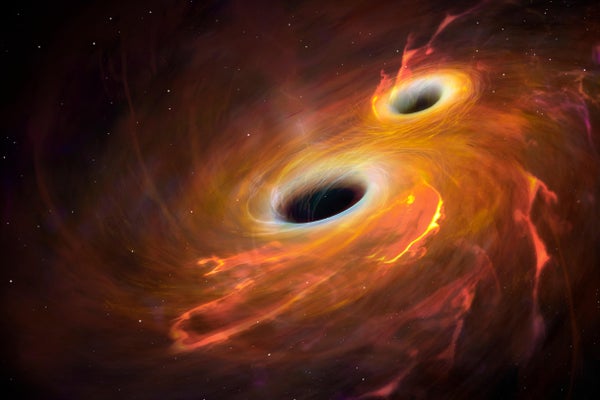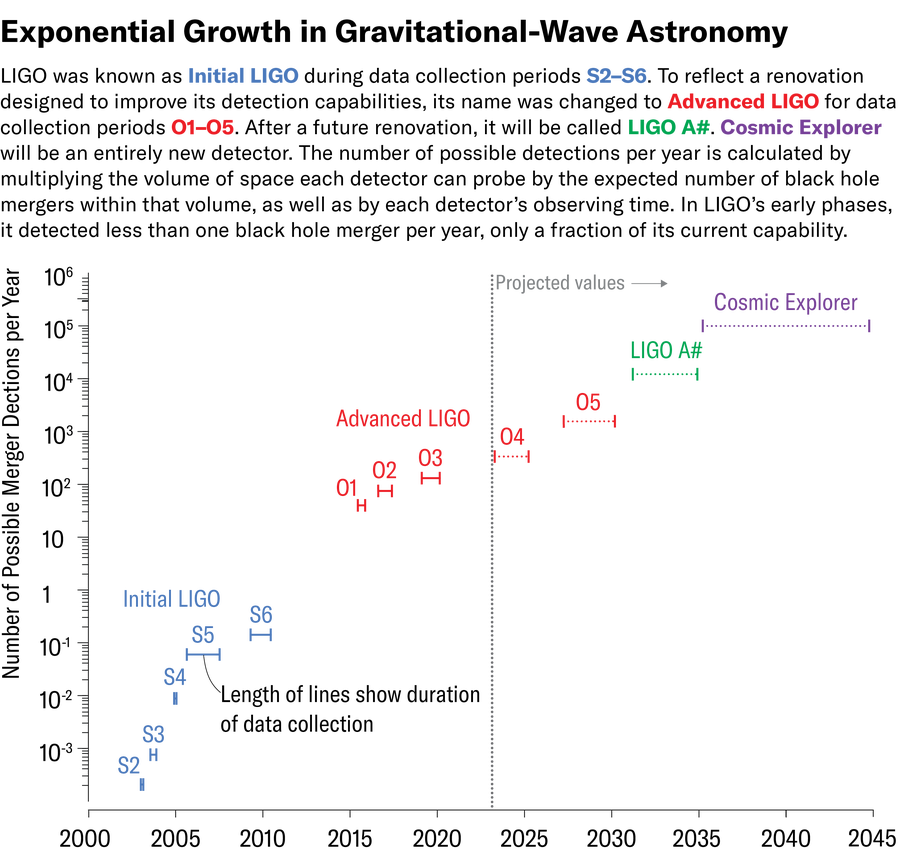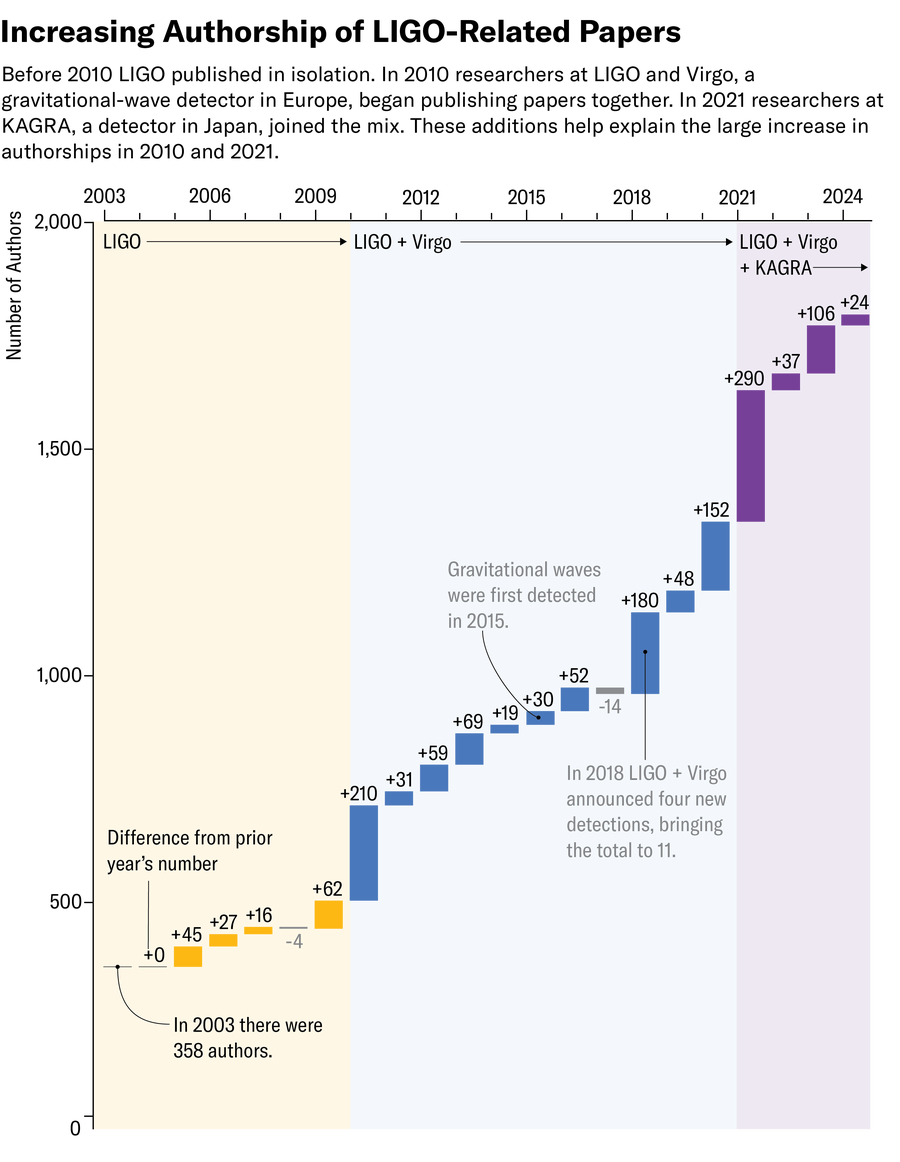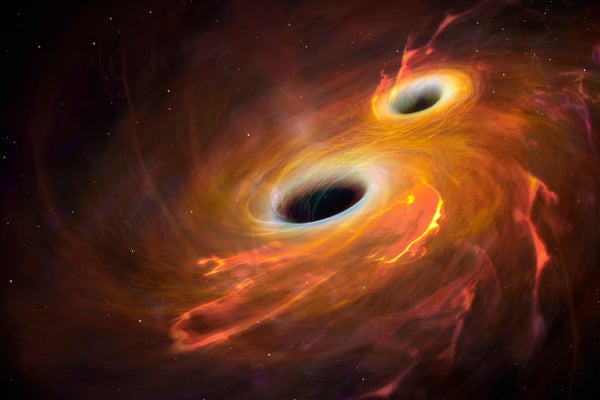September 4, 2024
5 min read
Black Hole Detectors Fulfill Moore’s Law
A famous prediction that microchips improve exponentially over time can be applicable in unrelated developments, such as the technology used to discover colliding black holes

An illustration of two black holes on the threshold of merging together, an event that produces copious gravitational waves.
Mark Garlick/Science Photo Library/Alamy Stock Photo
In 1965 the engineer and future Intel co-founder Gordon Moore famously noticed that the number of transistors on microchips has been exponentially growing for several years, and predicted their unstoppable increase would thenceforward drive computing. Now known as “Moore’s law,” this remarkable forecast has largely held ever since.
Given the constant changes and advances in making microchips, a consistent trend of exponential growth seems nothing short of miraculous. But in fact, various other realms of technological innovation now exhibit this trend, too. One that’s most interesting to us—and, so far, largely overlooked—is the ongoing development of a technology, called gravitational-wave antennas, which detects distant black holes.
Black holes form when gravity is so strong that no other force of nature can stop the collapse of matter. They most often are born from the deaths of massive stars, which have enough matter and density to trigger the runaway gravitational collapse. And such stellar-mass (or larger) black holes endure for very long periods of time—practically forever, in comparison to the lifetime of any star. Because of this, black holes are fairly ubiquitous in the universe, with many millions estimated to exist in our galaxy alone.
As these strange objects have extremely strong gravity, they pull in everything that approaches them, even light—hence the name black hole. While this makes them uniquely interesting, it also makes them difficult to observe. Fortunately, we can study them by virtue of their gravitational waves, ripples propagating out across space that arise when a black hole accelerates. We can detect these waves on Earth using sophisticated instruments that discern the perturbations of space caused by the waves’ passage. These changes are almost inconceivably minuscule—for instance, the distance between the sun and Earth (about 150 million kilometers!) changes less than the thickness of a human hair when a typical cosmic gravitational wave passes by.
The more that a black hole accelerates, the stronger its emitted gravitational waves will be, and thus the easier we can detect them here on Earth. It turns out that the best way to accelerate a black hole is to collide it with another black hole. These collisions from a cosmic billiard game are currently our key source of information about black holes.
Technology development to detect the collision of black holes began around the time Moore made his famous prediction, in the 1960s. It was neither easy nor cheap. While detectors improved over time, it took over half a century, and over a billion dollars, to reach the first actual detection, in 2015. Since then, however, the rapid improvement of detectors has brought new detections—new discoveries—at an ever-increasing rate, and up to today about 100 confirmed black hole collisions have been reported.
As Moore used the number of transistors in a microchip to quantify technological progress, we propose using the rate of detected collisions to quantify the advance of black hole detectors. Using this metric, we have studied the results from the most sensitive black hole detector, called the Laser Interferometer Gravitational-Wave Observatory (LIGO), and its planned upgrade called Cosmic Explorer, all to quantify past performance and forecast future improvement. We measured performance by the actual or expected number of detected collisions per year of observation, starting in 2000 and extending out to after 2040.
We found that the rate of technological improvement can be described remarkably well as exponential growth, starting with the first discovery in 2015 and projecting out some two decades into the future. The rate of detections has been doubling about every two years. And, provided Cosmic Explorer or its equivalent is actually built and operated, that trend will continue for quite some time. Moore’s law apparently applies to black hole detectors as well.

Zane Wolf; Sources: National Science Foundation; Szabolcs Márka; Imre Bartos
Improving and operating black hole detectors requires continuous investment—a requirement that was essentially fulfilled across the past quarter-century. Notably, exponential improvement in the detector rate did not come with a substantial increase of annual cost. This also means that detection is becoming vastly cheaper—another crucial aspect of Moore’s law, which forecasts not only that the density of transistors on microchips grows exponentially, but also that it does so at minimal increases in cost. While the effective cost of finding a black hole collision at the time of the first discovery, in 2015, was about $2 million, by around 2035 such a detection should cost less than $2,000.
As the improvement of microchips has transformed virtually every aspect of our lives since Moore’s prediction, so too may the rapid advancement of black hole detections transform how we understand the universe. From breakthrough insights on the nature of gravity or the lives and deaths of stars, to glimpsing the ultimate fate of the cosmos, this new and growing window onto the universe will undoubtedly change many of our astronomical beliefs.
While the importance of new discoveries is difficult to quantify, one measure of the importance of black hole collisions within science can be the number of scientists directly involved with black hole detectors. Looking at the number of authors of scientific publications of the LIGO detector team (along with collaborating black hole detectors Virgo and KAGRA), we see a fivefold increase between 2004 and 2024.
On supporting science journalism
If you’re enjoying this article, consider supporting our award-winning journalism by subscribing. By purchasing a subscription you are helping to ensure the future of impactful stories about the discoveries and ideas shaping our world today.

Zane Wolf; Sources: National Science Foundation; Szabolcs Márka; Imre Bartos
While microchips and black hole detectors rely on vastly different technology, their similar, exponential improvement over time may hint at more general technology trends and the nature of human progress. For instance, while no one intends to target a fixed rate of exponential growth for the sensitivity of black hole detectors, it may be difficult to justify funding for a technological improvement unless the result is markedly better than what is already available.
If exponential growth is indeed a more general technological trend, it may bring benefits beyond those embedded in the devices we now have in our hands. Setting expectations for the future state of technology can greatly help the planning required to make it a reality, as was done time and again for microchips and computing. Perhaps, just as exponential technological advancement has revolutionized computing and now transforms gravitational wave astronomy, in coming years we’ll see similar radical progress unfold in other domains, such as biotechnology and communications. Realizing the promise and peril of these powerful trends may be crucial preparation for our brave new future, whatever it might be.
This is an opinion and analysis article, and the views expressed by the author or authors are not necessarily those of Scientific American.

